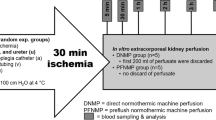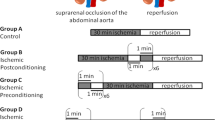Abstract
Background
Administration of ulinastatin was proved to protect many organs from ischemia/reperfusion (I/R) induced injury, yet its protective effects on renal I/R injury under cold condition and mechanism still remain unclear.
Aims
In the present study, the protective effects of ulinastatin on renal cold I/R injury as well as its mechanism were investigated.
Methods and results
Renal cold I/R model was constructed via cross-clamping of left renal artery and vein at 4 °C. The ulinastatin was administrated and multi-methods were performed to evaluate the protective effects. The results showed that ulinastatin could mitigate the renal cold I/R injury. In addition, the attenuated kidney cold I/R injury by ulinastatin was also accompanied with its regulating capability of the microenvironment, such as decreased acute inflammatory response, oxidative stress damage and apoptosis, as well as attenuation of vasculature levels decrease, as evidence by reduced TNF-α, IL-6 mRNA expression, MDA levels and apoptosis, higher levels of SOD activity and CD31/α-SMA expression.
Conclusion
The present study suggested that ulinastatin might be clinically useful in reducing preservation injury induced by cold I/R during renal transplantation surgery.






Similar content being viewed by others
References
Wekerle T, Segev D, Lechler R, Oberbauer R (2017) Strategies for long-term preservation of kidney graft function. Lancet 389:2152–2162
Liyanage T, Ninomiya T, Jha V, Neal B, Patrice HM, Okpechi I et al (2015) Worldwide access to treatment for end-stage kidney disease: a systematic review. Lancet 385:1975
Lindell SL, Muir H, Brassil J, Mangino MJ (2013) Hypothermic machine perfusion preservation of the DCD kidney: machine effects. J Transplant 2013:802618
Kosieradzki M, Rowiński W (2008) Ischemia/reperfusion injury in kidney transplantation: mechanisms and prevention. Transplantation proceedings. Elsevier, Amsterdam, pp 3279–3288
Henry SD, Guarrera JV (2012) Protective effects of hypothermic ex vivo perfusion on ischemia/reperfusion injury and transplant outcomes. Transplant Rev 26:163–175
Yuan X, Theruvath AJ, Ge X, Floerchinger B, Jurisch A, García-Cardeña G et al (2010) Machine perfusion or cold storage in organ transplantation: indication, mechanisms, and future perspectives. Transpl Int 23:561–570
Siedlecki A, Irish W, Brennan DC (2011) Delayed graft function in the kidney transplant. Am J Transplant 11:2279–2296
Schröppel B, Legendre C (2014) Delayed kidney graft function: from mechanism to translation. Kidney Int 86:251–258
Pan Y, Fang H, Lu F, Pan M, Chen F, Xiong P et al (2017) Ulinastatin ameliorates tissue damage of severe acute pancreatitis through modulating regulatory T cells. J Inflamm 14:7
Shin I-W, Jang I-S, Lee S-M, Park K-E, Ok S-H, Sohn J-T et al (2011) Myocardial protective effect by ulinastatin via an anti-inflammatory response after regional ischemia/reperfusion injury in an in vivo rat heart model. Korean J Anesthesiol 61:499–505
Umeadi C, Kandeel F, Alabdullah IH (2008) Ulinastatin is a novel protease inhibitor and neutral protease activator. Transplant Proc 40:387–389
Chen Q, Hu C, Liu Y, Liu Y, Wang W, Zheng H et al (2017) Safety and tolerability of high-dose ulinastatin after 2-hour intravenous infusion in adult healthy Chinese volunteers: a randomized, double-blind, placebo-controlled, ascending-dose study. PLoS One 12:e0177425
Zhong DF, Xu Q (2011) The clinical observation of high-dose ulinastatin in septic shock. Chin J Clin Ration Drug Use 4:41–42
Zhang A, Dong XJ (2008) Clinical trial of combined ulinastatin and octreotide in treatment of severe acute pancreatitis. Chin J Clin Pharmacol 24:104
Xu L, Ren B, Li M, Jiang F, Zhanng Z, Hu J (2008) Ulinastatin suppresses systemic inflammatory response following lung ischemia-reperfusion injury in rats. Transplantation proceedings. Elsevier, Amsterdam, pp 1310–1311
Cao Z-L, Okazaki Y, Naito K, Ueno T, Natsuaki M, Itoh T (2000) Ulinastatin attenuates reperfusion injury in the isolated blood-perfused rabbit heart. Ann Thorac Surg 69:1121–1126
Okuhama Y, Shiraishi M, Higa T, Tomori H, Taira K, Mamadi T et al (1999) Protective effects of ulinastatin against ischemia–reperfusion injury. J Surg Res 82:34–42
Xiaoqiao Z, Rong M, Zhigang Y, Yong D, Xihong F, Jingzhong S (2004) Protective effect of ulinastatin against ischemia-reperfusion injury in rat small bowel transplantation. Transplantation proceedings. Elsevier, Amsterdam, pp 1564–1566
Xu M, Wen X, Chen S, An X, Xu H (2011) Addition of ulinastatin to preservation solution promotes protection against ischemia-reperfusion injury in rabbit lung. Chin Med J 124:2179–2183
Chen C-C, Liu Z-M, Wang H-H, He W, Wang Y, Wu W-D (2004) Effects of ulinastatin on renal ischemia-reperfusion injury in rats. Acta Pharmacol Sin. 2004(25):1334
Wang Y-L, Li G, Zou X-F, Chen X-B, Liu T, Shen Z-Y (2013) Effect of autologous adipose-derived stem cells in renal cold ischemia and reperfusion injury. Transplantation proceedings. Elsevier, Amsterdam, pp 3198–3202
Ayala A, Munoz MF, Arguelles S (2014) Lipid peroxidation: production, metabolism, and signaling mechanisms of malondialdehyde and 4-hydroxy-2-nonenal. Oxid Med Cell Longev 2014:360438
Vieira SA, Zhang G, Decker EA (2017) Biological implications of lipid oxidation products. J Am Oil Chem Soc 94:339–351
Schneider MP, Sullivan JC, Wach PF, Boesen EI, Yamamoto T, Fukai T et al (2010) Protective role of extracellular superoxide dismutase in renal ischemia/reperfusion injury. Kidney Int 78:374–381
Rao PS, Ojo A (2009) The alphabet soup of kidney transplantation: SCD, DCD, ECD—fundamentals for the practicing nephrologist. Clin J Am Soc Nephrol 4:1827–1831
Matas A, Smith J, Skeans M, Thompson B, Gustafson S, Schnitzler M et al (2014) OPTN/SRTR 2012 annual data report: kidney. Am J Transplant 14:11–44
Lutz J, Thürmel K, Heemann U (2010) Anti-inflammatory treatment strategies for ischemia/reperfusion injury in transplantation. J Inflamm 7:27
Mahmoud MF, El Shazly SM, Barakat W (2012) Inhibition of TNF-α protects against hepatic ischemia–reperfusion injury in rats via NF-κB dependent pathway. Naunyn-Schmiedeberg’s Arch Pharmacol 385:465–471
Donnahoo KK, Meng X, Ayala A, Cain MP, Harken AH, Meldrum DR (1999) Early kidney TNF-α expression mediates neutrophil infiltration and injury after renal ischemia-reperfusion. Am J Physiol-Regul Integr Compar Physiol 277:R922–R929
Torre-Amione G, Kapadia S, Lee J, Bies RD, Lebovitz R, Mann DL (1995) Expression and functional significance of tumor necrosis factor receptors in human myocardium. Circulation 92:1487–1493
Sack MN (2002) Tumor necrosis factor-α in cardiovascular biology and the potential role for anti-tumor necrosis factor-α therapy in heart disease. Pharmacol Ther 94:123–135
Chen W, Shen X, Hu Y, Xu K, Ran Q, Yu Y et al (2017) Surface functionalization of titanium implants with chitosan-catechol conjugate for suppression of ROS-induced cells damage and improvement of osteogenesis. Biomaterials 114:82–96
Cuzzocrea S, Riley DP, Caputi AP, Salvemini D (2001) Antioxidant therapy: a new pharmacological approach in shock, inflammation, and ischemia/reperfusion injury. Pharmacol Rev 53:135–159
Li J, Shu Y, Hao T, Wang Y, Qian Y, Duan C et al (2013) A chitosan–glutathione based injectable hydrogel for suppression of oxidative stress damage in cardiomyocytes. Biomaterials 34:9071–9081
Lin M, Li L, Li L, Pokhrel G, Qi G, Rong R et al (2014) The protective effect of baicalin against renal ischemia-reperfusion injury through inhibition of inflammation and apoptosis. BMC Complement Altern Med. 14:19
Yang M, Antoine DJ, Weemhoff JL, Jenkins RE, Farhood A, Park BK et al (2014) Biomarkers distinguish apoptotic and necrotic cell death during hepatic ischemia/reperfusion injury in mice. Liver Transpl 20:1372–1382
Scarabelli T, Stephanou A, Rayment N, Pasini E, Comini L, Curello S et al (2001) Apoptosis of endothelial cells precedes myocyte cell apoptosis in ischemia/reperfusion injury. Circulation 104:253–256
Czabotar PE, Lessene G, Strasser A, Adams JM (2014) Control of apoptosis by the BCL-2 protein family: implications for physiology and therapy. Nat Rev Mol Cell Biol 15:49–63
Borghetti G, Yamaguchi AA, Aikawa J, Yamazaki RK, Brito GAP, Fernandes LC (2015) Fish oil administration mediates apoptosis of Walker 256 tumor cells by modulation of p53, Bcl-2, caspase-7 and caspase-3 protein expression. Lipids Health Dis 14:94
Author information
Authors and Affiliations
Corresponding author
Ethics declarations
Conflict of interest
The authors declare no competing financial interests in the present study.
Additional information
Publisher's Note
Springer Nature remains neutral with regard to jurisdictional claims in published maps and institutional affiliations.
Rights and permissions
About this article
Cite this article
Wang, Y., Peng, C., Zhang, Z. et al. Intravenous infusion of ulinastatin attenuates acute kidney injury after cold ischemia/reperfusion. Int Urol Nephrol 51, 1873–1881 (2019). https://doi.org/10.1007/s11255-019-02204-3
Received:
Accepted:
Published:
Issue Date:
DOI: https://doi.org/10.1007/s11255-019-02204-3




